Materials Used In This Watercolor Study:
- Reference picture of Monet’s Water Lilies
- A block of Hahnemühle’s Cornwall cold press watercolor paper (210lb, size 9.4″ x 12.6″)
- Pentel Graphgear 1000 automatic drafting pencil, 0.7mm lead size with 2B lead
- Painting palette for watercolor paints
- A container of water
- Paper towels or a rag
- A tabletop easel or a box to prop your painting on
- A spray bottle with clean water
- Staedtler Mars Plastic eraser
- Auxiliary plate or palette for gouache paint
Paints (Holbein Artists’ Watercolors)
- Brilliant Pink
- Cerulean Blue
- Cobalt Green
- Turquoise Blue
- Phthalo Blue
- Permanent Alizarin Crimson
- Pyrrole Red
- Carmine
- Cadmium Yellow Lemon
- Naples Yellow
- Olive Green
Daniel Smith’s Extra Fine Watercolors
Holbein Artists’ Gouache
- Permanent White
Brushes
- Escoda Perla Joseph Zbukvic Series: Round brush (no. 20)
- Escoda Perla Joseph Zbukvic Series: Round brush (no. 12)
- Escoda Perla Joseph Zbukvic Series: Round brush (no. 8)
- Winsor & Newton Sceptre Gold II Series 303: Short handle lettering/rigger brush (no. 1)
Step 1: Preparing the Painting Area
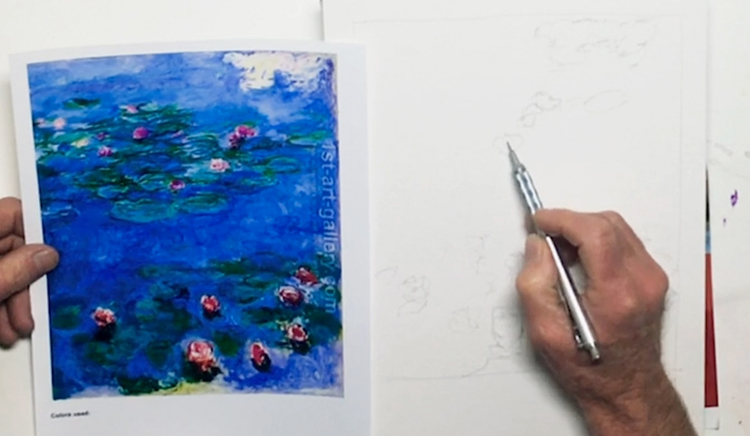 Claude Monet was one of the founders of Impressionism and is known for his creative experiments with color and lighting. The painting we'll be studying today is but one of several in Monet's Water Lilies series. If you're eager to learn more about color theory and color temperature, this is the right place to be! For this study, Bill draws a border around the area where he wants the painting to be. You can create a neat, freehand border this way by touching a finger to the edge of the watercolor block and using it to guide your drawing hand. In doing your sketch, keep your lines light and loose. The elements in this painting are fairly simple so you don't have to draw in a lot of detail. You can always do this with your brush later on. Be mindful of how the composition of the piece draws the eye. The illusion of perspective is created by making the flowers at the bottom of the frame bigger, appearing closer to the front, while the flowers at the top are smaller to look more distant. Here's a close up of Bill's sketch:
Claude Monet was one of the founders of Impressionism and is known for his creative experiments with color and lighting. The painting we'll be studying today is but one of several in Monet's Water Lilies series. If you're eager to learn more about color theory and color temperature, this is the right place to be! For this study, Bill draws a border around the area where he wants the painting to be. You can create a neat, freehand border this way by touching a finger to the edge of the watercolor block and using it to guide your drawing hand. In doing your sketch, keep your lines light and loose. The elements in this painting are fairly simple so you don't have to draw in a lot of detail. You can always do this with your brush later on. Be mindful of how the composition of the piece draws the eye. The illusion of perspective is created by making the flowers at the bottom of the frame bigger, appearing closer to the front, while the flowers at the top are smaller to look more distant. Here's a close up of Bill's sketch: 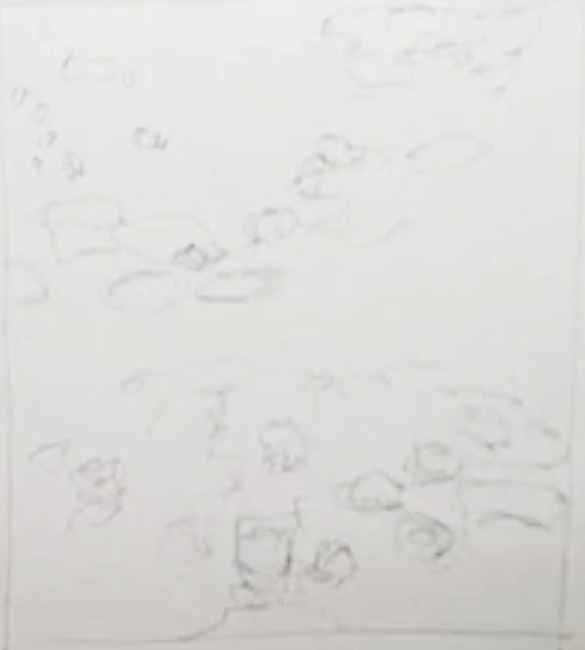
Step 2: Establishing the Base Layer
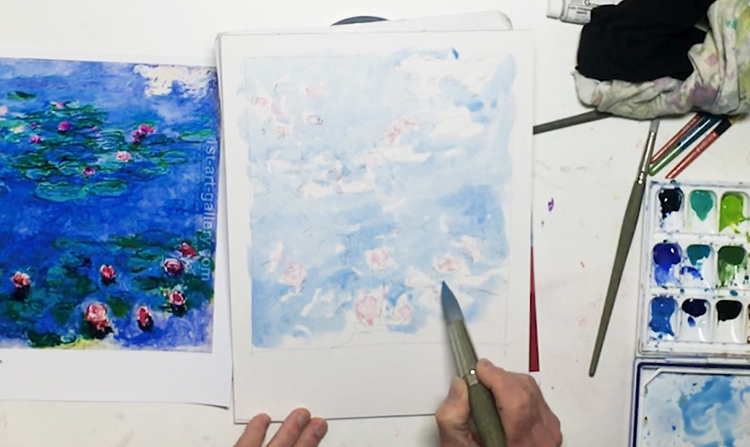 With a no. 20 round brush, pick up Brilliant Pink and use dabs of paint to establish the flowers. Monet's water lilies are the central characters in this painting, so try to avoid muddying the pink with other colors. Next, take Cerulean Blue and paint the water in loose strokes. Work wet-in-dry (i.e. adding wet paint to a dry surface) in a horizontal fashion starting at the top of the frame, and paint around the flowers and lighter areas of the painting. A unique feature of Cerulean Blue is that it's a granulating color. This means it produces a grainy effect when dry, which you can use to add interesting textures to your painting. At this stage you're simply laying down the base colors, so it's fine to keep the colors light for now.
With a no. 20 round brush, pick up Brilliant Pink and use dabs of paint to establish the flowers. Monet's water lilies are the central characters in this painting, so try to avoid muddying the pink with other colors. Next, take Cerulean Blue and paint the water in loose strokes. Work wet-in-dry (i.e. adding wet paint to a dry surface) in a horizontal fashion starting at the top of the frame, and paint around the flowers and lighter areas of the painting. A unique feature of Cerulean Blue is that it's a granulating color. This means it produces a grainy effect when dry, which you can use to add interesting textures to your painting. At this stage you're simply laying down the base colors, so it's fine to keep the colors light for now.
Step 3: Creating a Watery Depth
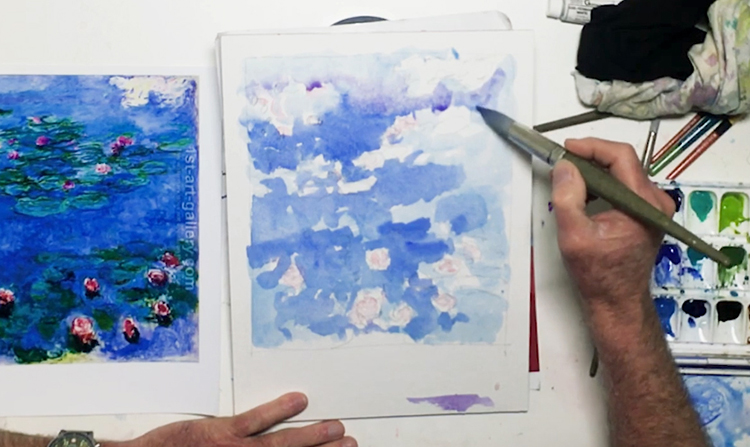 Pick up Cobalt Blue and add another layer to the water, working wet-in-wet (i.e. adding wet paint to an already wet surface) so that the colors blend into each other. Add more to the darker areas, referring to your reference image for guidance. Next, dilute a bit of Carbazole Violet so it becomes a pale lavender tint. Use this to add a subtle purple to the water. You can also reactivate any dry sections by painting over them with clean water and adding the color via the wet-in-wet technique.
Pick up Cobalt Blue and add another layer to the water, working wet-in-wet (i.e. adding wet paint to an already wet surface) so that the colors blend into each other. Add more to the darker areas, referring to your reference image for guidance. Next, dilute a bit of Carbazole Violet so it becomes a pale lavender tint. Use this to add a subtle purple to the water. You can also reactivate any dry sections by painting over them with clean water and adding the color via the wet-in-wet technique.
Step 4: Blocking in the Lily Pads
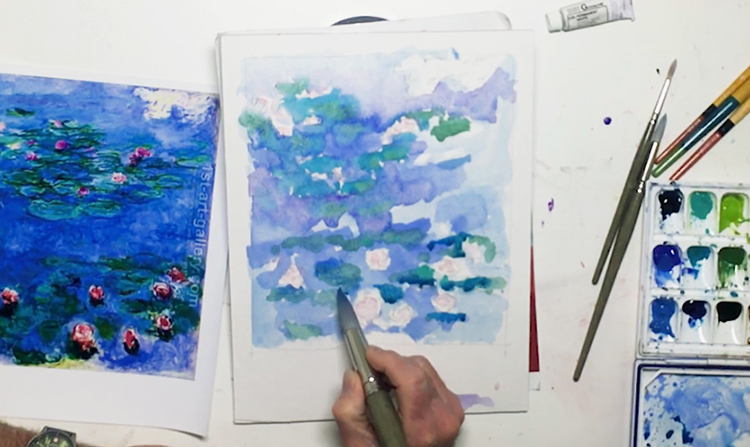 While the water layer is still wet, mix Cobalt Green and Turquoise Blue and paint the lily pads. Work wet-in-wet and allow some of the blue-green tint to blend with the blue of the water. Continue to paint around the flowers and allow some of the white of the paper to show through. Next, pick up Chromium Green Oxide to strengthen the green in the lily pads, particularly the ones at the bottom of the frame. Use a mixture of Phthalo and Cobalt Blue for the darker sections of the lily pads.
While the water layer is still wet, mix Cobalt Green and Turquoise Blue and paint the lily pads. Work wet-in-wet and allow some of the blue-green tint to blend with the blue of the water. Continue to paint around the flowers and allow some of the white of the paper to show through. Next, pick up Chromium Green Oxide to strengthen the green in the lily pads, particularly the ones at the bottom of the frame. Use a mixture of Phthalo and Cobalt Blue for the darker sections of the lily pads.
Step 5: Building up Monet's Water Lilies
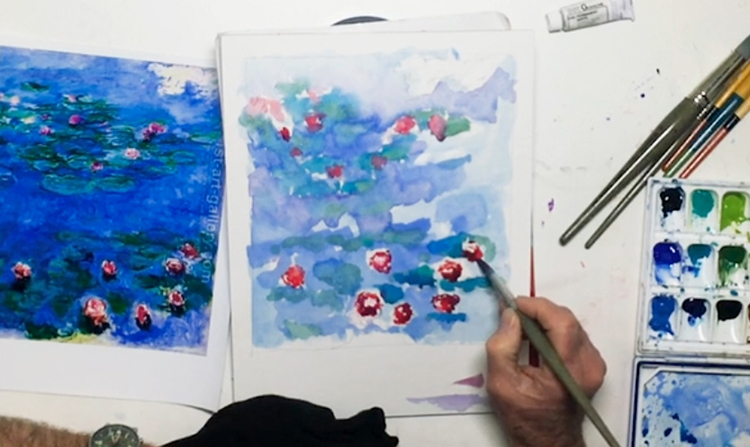 Now let's add some definition to those water lilies! To work on a smaller scale, switch to a no. 12 round brush. Begin by picking up Brilliant Pink and working wet-in-dry on the flowers. Use Permanent Alizarin Crimson for the darker parts, but be mindful to not let it overpower the pinks in the background flowers. Notice how Monet's water lilies are different shades of red? The flowers in the foreground have a reddish tint, while the ones in the background are more purple. This is how Monet uses color temperature to create the illusion of depth. Cool colors tend to make objects fade into the background while warm colors bring objects forward. With that in mind, use Pyrrole Red to add details to the water lilies at the bottom. You can also use Carmine if you want to add more warmth. Finally, mix some Cobalt Blue with Permanent Alizarin Crimson for a dark red-purple mixture, and use this on the shadows of the flowers in the back. Since these flowers are in the distance, they don't need to have too many details.
Now let's add some definition to those water lilies! To work on a smaller scale, switch to a no. 12 round brush. Begin by picking up Brilliant Pink and working wet-in-dry on the flowers. Use Permanent Alizarin Crimson for the darker parts, but be mindful to not let it overpower the pinks in the background flowers. Notice how Monet's water lilies are different shades of red? The flowers in the foreground have a reddish tint, while the ones in the background are more purple. This is how Monet uses color temperature to create the illusion of depth. Cool colors tend to make objects fade into the background while warm colors bring objects forward. With that in mind, use Pyrrole Red to add details to the water lilies at the bottom. You can also use Carmine if you want to add more warmth. Finally, mix some Cobalt Blue with Permanent Alizarin Crimson for a dark red-purple mixture, and use this on the shadows of the flowers in the back. Since these flowers are in the distance, they don't need to have too many details.
Step 6: Adding Depth and Texture
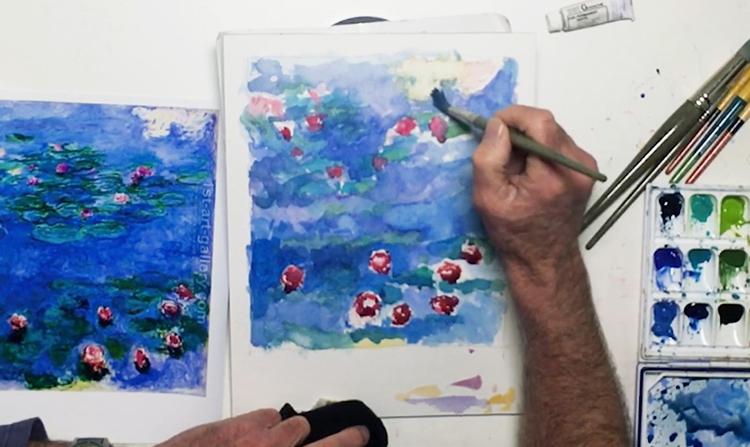 Let's build up the water now that the first few layers have dried. The upper right corner of the painting has a subtle yellow tint which you can capture by mixing Cadmium Yellow Lemon and Naples Yellow. Dilute this mixture with water so it doesn't stand out too much. If it's still too strong, you can mute it with Brilliant Pink. Mix together Chromium Green Oxide and Phthalo Blue for a deep blue-green tint and use this on the green shadows in the water. Use Cobalt and Phthalo Blue to deepen the color of the water on the left side, painting around the flowers and working wet-in-wet. Phthalo Blue is a staining color and may dull your reds, so use the tip of your brush to control your strokes. You can also dab your brush on the page to create interesting textures in your painting.
Let's build up the water now that the first few layers have dried. The upper right corner of the painting has a subtle yellow tint which you can capture by mixing Cadmium Yellow Lemon and Naples Yellow. Dilute this mixture with water so it doesn't stand out too much. If it's still too strong, you can mute it with Brilliant Pink. Mix together Chromium Green Oxide and Phthalo Blue for a deep blue-green tint and use this on the green shadows in the water. Use Cobalt and Phthalo Blue to deepen the color of the water on the left side, painting around the flowers and working wet-in-wet. Phthalo Blue is a staining color and may dull your reds, so use the tip of your brush to control your strokes. You can also dab your brush on the page to create interesting textures in your painting.
Step 7: Adding Layers to the Lily Pads
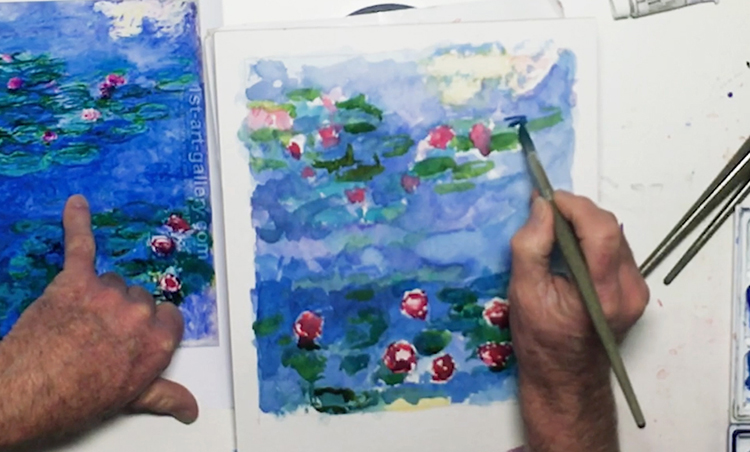 Once the lily pads have dried, add another layer of color to them with your Chromium Green Oxide and Phthalo Blue mixture. Block in the lily pads in the foreground, and work wet-in-dry as you paint around the flowers. Remember, you're trying to achieve the brightness of Monet's water lilies by making sure your reds aren't muddied by other colors. Add Cadmium Yellow Lemon to the green mixture in order to brighten it, then add this to the lily pads in the background. Use dabs of Olive and Cobalt Green to strengthen the green sections in your painting. It's okay to allow the green to bleed into the blue of the water in certain areas. The lily pads practically blend into the water, so play with soft and hard edges to create this effect.
Once the lily pads have dried, add another layer of color to them with your Chromium Green Oxide and Phthalo Blue mixture. Block in the lily pads in the foreground, and work wet-in-dry as you paint around the flowers. Remember, you're trying to achieve the brightness of Monet's water lilies by making sure your reds aren't muddied by other colors. Add Cadmium Yellow Lemon to the green mixture in order to brighten it, then add this to the lily pads in the background. Use dabs of Olive and Cobalt Green to strengthen the green sections in your painting. It's okay to allow the green to bleed into the blue of the water in certain areas. The lily pads practically blend into the water, so play with soft and hard edges to create this effect.
Step 8: Using Contrast to Create Interest
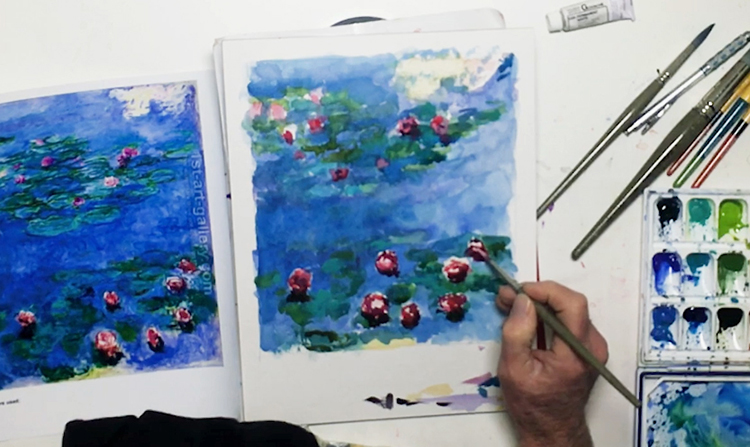 We're on the final stretch now! Let's add some final touches by strengthening the values in your painting. Switch to a no. 8 round brush and mix together Carbazole Violet and Olive Green to produce a deep purple tint. Add this to the bottom of the flowers in the foreground to make them pop. For the background flowers' shadows, use a touch of Brilliant Pink and Permanent Alizarin Crimson. Next, squeeze out some Permanent White gouache onto your palette and touch up the whites of the foreground water lilies. Mix in Permanent Alizarin Crimson to make a pale pink tint for the highlights on the lilies in the back. Monet's water lilies really leap off the canvas, and now so do yours! For the final step, take a lettering brush and sign your name in deep pink (credit the original artist too!). And there you have it, you have now finished a study of a Monet masterpiece!
We're on the final stretch now! Let's add some final touches by strengthening the values in your painting. Switch to a no. 8 round brush and mix together Carbazole Violet and Olive Green to produce a deep purple tint. Add this to the bottom of the flowers in the foreground to make them pop. For the background flowers' shadows, use a touch of Brilliant Pink and Permanent Alizarin Crimson. Next, squeeze out some Permanent White gouache onto your palette and touch up the whites of the foreground water lilies. Mix in Permanent Alizarin Crimson to make a pale pink tint for the highlights on the lilies in the back. Monet's water lilies really leap off the canvas, and now so do yours! For the final step, take a lettering brush and sign your name in deep pink (credit the original artist too!). And there you have it, you have now finished a study of a Monet masterpiece!



